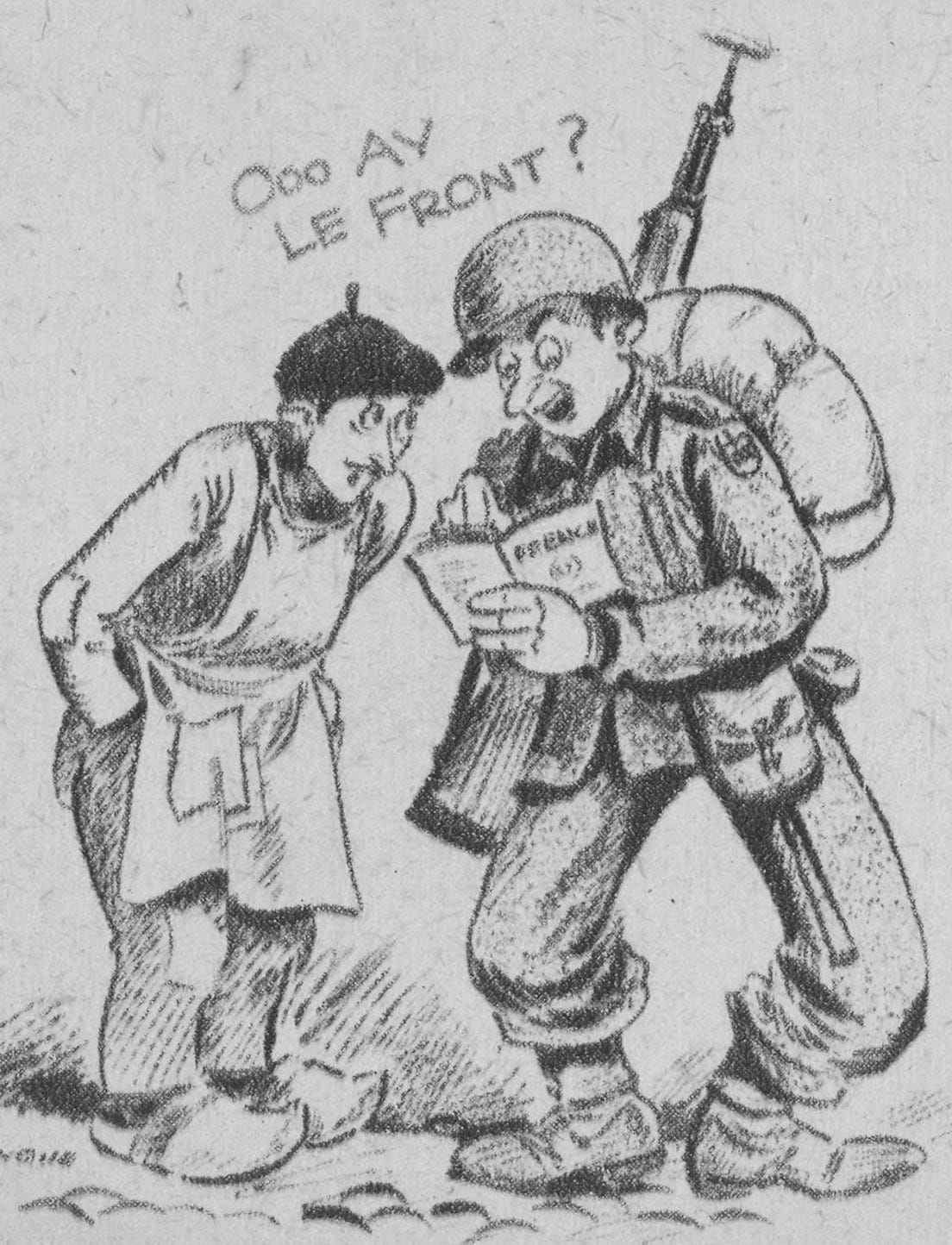After six short days of unloading, melting cosmoline, and reassembling equipment, the reason that that they were told to hurry became clear. On October 26th, they learned that the 399th regimental combat team—including Company C of the combat engineers—was rushing to the front. That evening, Berlin Sally let them know she not only knew it too, she knew where they were going, which they did not. She welcomed the 100th Division to the front lines in the Belfort Gap.[1]
The next day, the 399th regimental combat team loaded up to head north. One of the men recalled:
We load up while the drivers warm their engines. The trucks roar through their low gears, file out of the lot and turn North…As far as one can see, there are trucks before and behind us. The sense of unleashed power is awesome…We are small cogs in a very big juggernaut of war.[2]
At first, the trip was ok. The road snaked along the Rhone River. It was late October, the leaves were bright colors, the meadows were still green, the afternoon sun warm, and the night cool.[3] It was their first experience of a feature of a truck convoy—the nature break. The whole long line would stop. All the men would pile out and relieve themselves en masse along the side of the road. The towns were only five miles apart and farmhouses were always in sight. The convoys stretched for miles.[4] Dad thought that was hilarious. After Company C liberated German cameras late in the war, he took a picture because he thought 5000 men taking a piss was funny.
At first, they slowed considerably going through the small towns. People came out waving French and American flags and shouting: “the children watch and wave, shout and laugh! We float in a carnival atmosphere.” The second day they drove from Lyons to Dijon and the atmosphere changed. As one GI recalled:
“A cold north wind is summoned by the sunset. Suddenly to our right, we get a different chill from the sight of dead horses and cattle lying in a peaceful field. We watch the scene pass in stunned silence. Gone are the cheering crowds; we see no more people and no traffic but our own.”[5]
On the third day, the highways were littered with wreckage. The convoy passed miles of burned-out tanks and trucks and horse-drawn carts—a German convoy strafed by American planes. A few of the villages they drove through on the third day had been blown apart, with just a chimney here, a wall there, the contents of the houses strewn everywhere. The convoy passed dozens of dead GIs laid out along the road, covered in cotton mattress covers. The men realized in that moment why they’d packed a cotton mattress cover in their duffel bags. They had packed their own shrouds. The Army had thought of everything.[6]
When I asked T.C. what it was like to head to the front, he told me,
“There was still enough war when we got over there for me. I tell you. The aircraft or something, shooting and killing people. It’s something. I remember moving up in the night, we run over something in the road and we found out the whole convoy went over a dead German in the road. And parts of people in the trees and body parts everywhere…. Sherman had the right word for war--hell. I tell you, you never want to do it again.”
In the late afternoon of October 31, 1944, the 399th combat team was dumped out onto the side of the road. The men didn’t know where they were. They were near a town called Fremifontaine, but that wouldn’t have meant anything to them if they had known.
All of the memoirs of the 399th regimental combat team recall the same experience. It was dark. There were flashes in the night sky from artillery shells in the distance. The roots under the trees formed a tough mass, so they dug half-hearted shallow trenches in the difficult terrain and rolled up in their bed rolls on the hard cold ground. At two in the morning, they all woke up, rocked by a tremendous nearby explosion, followed by more. The sky lit up. Everyone grabbed their shovels and dug, roots or no. As one recalled that night, “It is amazing how much dirt a man can move when he wants to.”[7] They got deep enough to be below ground when word circulated that the explosions were out-going 155-mm guns from their own artillery.[8] They realized that even after years of training they were bewildered and very green.[9]
At dawn, they turned in their duffel bags. They wouldn’t see those bags for six months. On November 1, 1944, the 399th Regimental Combat Team entered combat, just 26 days after leaving Manhattan. They didn’t know it then, but it was a record for the fastest deployment of any unit in the war.
[1]Tyson and Hamer 2001, p. 8).
[2]Hancock 1997, p. 70)
[3]Hancock 1997, p. 71)
[4]Hancock 1997, p. 71)
[5]Hancock 1997, p. 71)
[6]Khoury 2003, p. 29)
[7]Fishpaw and Fishpaw 1998, p. 138)
[8]Hancock 1997, p. 72)
[9]Bruner et al. 1945.
My Father's War in Real Time
I’m working on a book that covers the arc of my parents’ experience in World War II. A list of chapters and the prologue are here: https://patricia-morse.com/the-things-they-left-unsaid/






Perhaps you met a local man (abt to turn 100) named Marcel in Fremifontaine, who is known as a Resistance fighter.